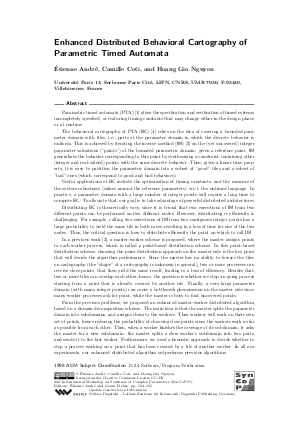Enhanced Distributed Behavioral Cartography of Parametric Timed Automata (Informal Presentation)
Authors Étienne André, Camille Coti, Hoang Gia Nguyen
-
Part of:
Volume:
2nd International Workshop on Synthesis of Complex Parameters (SynCoP'15) (SynCoP 2015)
Part of: Series: Open Access Series in Informatics (OASIcs) - License:
 Creative Commons Attribution 3.0 Unported license
Creative Commons Attribution 3.0 Unported license
- Publication Date: 2015-12-03
File

PDF
OASIcs.SynCoP.2015.104.pdf
- Filesize: 228 kB
- 2 pages
Document Identifiers
Subject Classification
Keywords
- Formal methods
- model checking
- distributed algorithmic
- real-time systems
- parameter synthesis
Metrics
- Access Statistics
-
Total Accesses (updated on a weekly basis)
0Document
0Metadata
Abstract
Parametric timed automata (PTA) allow the specification and verification of timed systems incompletely specified, or featuring timing constants that may change either in the design phase, or at runtime. The behavioral cartography of PTA (BC) relies on the idea of covering a bounded parameter domain with tiles, i.e., parts of the parameter domain in which the discrete behavior is uniform. This is achieved by iterating the inverse method (IM) on the (yet uncovered) integer parameter valuations ("points") of the bounded parametric domain: given a reference point, IM generalizes the behavior corresponding to this point by synthesizing a constraint containing other (integer and real-valued) points with the same discrete behavior. Then, given a linear time property, it is easy to partition the parametric domain into a subset of "good" tiles and a subset of "bad" ones (which correspond to good and bad behaviors).
Useful applications of BC include the optimization of timing constants, and the measure of the system robustness (values around the reference parameters) w.r.t. the untimed language. In practice, a parameter domain with a large number of integer points will require a long time to compute BC. To alleviate that, our goal is to take advantage of powerful distributed architectures. Distributing BC is theoretically easy, since it is trivial that two executions of IM from two different points can be performed on two different nodes. However, distributing it efficiently is challenging. For example, calling two executions of IM from two contiguous integer points has a large probability to yield the same tile in both cases, resulting in a loss of time for one of the two nodes. Thus, the critical question is how to distribute efficiently the point on which to call IM. In a previous work, a master-worker scheme is proposed, where the master assigns points to each worker process, which is called a point-based distribution scheme. In this point-based distribution scheme, choosing the point distribution approach on the master side is the key point that will decide the algorithm performance. Since the master has no ability to foresee the tiles
on cartography (the "shape" of a cartography is unknown in general), two or more processes can receive close points, that then yield the same result, leading to a loss of efficiency. Besides that, two or more tiles can overlap each other; hence, the question is whether we stop an going process starting from a point that is already covered by another tile. Finally, a very large parameter domain (with many integer points) can cause a bottleneck phenomenon on the master side since many worker processes ask for point, while the master is busy to find uncovered points. From the previous problems, we proposed an enhanced master-worker distributed algorithm, based on a domain decomposition scheme. The main idea is that the master splits the parameter domain into subdomains, and assigns them to the workers. Then workers will work on their own set of points, hence reducing the probability of choosing close points since the workers work as far as possible from each other. Then, when a worker finishes the coverage of its subdomain, it asks the master for a new subdomain: the master splits a slow worker's subdomain into two parts, and sends it to the fast worker. Furthermore, we used a heuristic approach to decide whether to stop a process working on a point that has been covered by a tile of another worker. In all our experiments, our enhanced distributed algorithm outperforms previous algorithms.
Cite As Get BibTex
Étienne André, Camille Coti, and Hoang Gia Nguyen. Enhanced Distributed Behavioral Cartography of Parametric Timed Automata (Informal Presentation). In 2nd International Workshop on Synthesis of Complex Parameters (SynCoP'15). Open Access Series in Informatics (OASIcs), Volume 44, pp. 104-105, Schloss Dagstuhl – Leibniz-Zentrum für Informatik (2015)
https://doi.org/10.4230/OASIcs.SynCoP.2015.104
BibTex
@InProceedings{andre_et_al:OASIcs.SynCoP.2015.104,
author = {Andr\'{e}, \'{E}tienne and Coti, Camille and Nguyen, Hoang Gia},
title = {{Enhanced Distributed Behavioral Cartography of Parametric Timed Automata}},
booktitle = {2nd International Workshop on Synthesis of Complex Parameters (SynCoP'15)},
pages = {104--105},
series = {Open Access Series in Informatics (OASIcs)},
ISBN = {978-3-939897-82-8},
ISSN = {2190-6807},
year = {2015},
volume = {44},
editor = {Andr\'{e}, \'{E}tienne and Frehse, Goran},
publisher = {Schloss Dagstuhl -- Leibniz-Zentrum f{\"u}r Informatik},
address = {Dagstuhl, Germany},
URL = {https://drops.dagstuhl.de/entities/document/10.4230/OASIcs.SynCoP.2015.104},
URN = {urn:nbn:de:0030-drops-56134},
doi = {10.4230/OASIcs.SynCoP.2015.104},
annote = {Keywords: Formal methods, model checking, distributed algorithmic, real-time systems, parameter synthesis}
}
Author Details
References
-
Rajeev Alur, Thomas A. Henzinger, and Moshe Y. Vardi. Parametric real-time reasoning. In STOC, pages 592-601. ACM, 1993.

-
Étienne André, Thomas Chatain, Emmanuelle Encrenaz, and Laurent Fribourg. An inverse method for parametric timed automata. International Journal of Foundations of Computer Science, 20(5):819-836, 2009.

-
Étienne André, Camille Coti, and Sami Evangelista. Distributed behavioral cartography of timed automata. In EuroMPI/ASIA, pages 109-114. ACM, 2014.

-
Étienne André and Laurent Fribourg. Behavioral cartography of timed automata. In RP, volume 6227 of Lecture Notes in Computer Science, pages 76-90. Springer, 2010.

